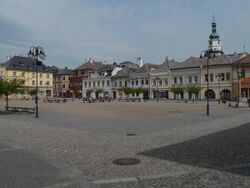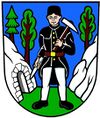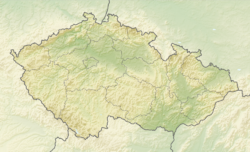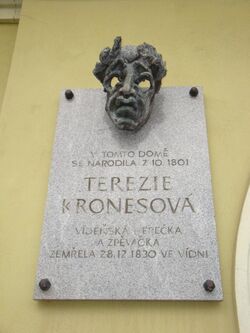Bruntál
Topic: Place
 From HandWiki - Reading time: 12 min
From HandWiki - Reading time: 12 min
Bruntál | |
|---|---|
Town | |
 Peace Square in Bruntál | |
| Coordinates: [ ⚑ ] : 49°59′18″N 17°27′53″E / 49.98833°N 17.46472°E | |
| Country | |
| Region | Moravian-Silesian |
| District | Bruntál |
| Founded | 1213 |
| Government | |
| • Mayor | Petr Rys |
| Area | |
| • Total | 29.34 km2 (11.33 sq mi) |
| Elevation | 409 m (1,342 ft) |
| Population (2020-01-01[1]) | |
| • Total | 16,138 |
| • Density | 550/km2 (1,400/sq mi) |
| Time zone | UTC+1 (CET) |
| • Summer (DST) | UTC+2 (CEST) |
| Postal code | 792 01 |
| Website | www |
Bruntál (Czech pronunciation: [ˈbruntaːl]; German: Freudenthal in Schlesien, Latin: Vallis Gaudiorum, Vrudental) is a town in the Moravian-Silesian Region of the Czech Republic. It has about 16,000 inhabitants. It is located in the historical region of Czech Silesia. A suitable position in the middle of the Jeseníky Mountains provides ample tourism opportunities to the town, which offers sites of cultural interest that include a Baroque castle and many historical buildings.
Geography
Bruntál is situated between the Hrubý Jeseník mountains and the rolling hills of the Nízký Jeseník mountains. The town lies in a valley surrounded by several hills (Uhlířský vrch, 672 m (2,205 ft); Vodárenský vrch, 599 m (1,965 ft); Zadní Zelený vrch, 563 m (1,847 ft); Kozinec, 639 m (2,096 ft)). The Černý Creek with its tributaries, the creeks Bukový, Kobylí and Vodárenský, run through Bruntál. The Kobylí Pond is located in the middle of the town. The Bukový Pond with a surface area of 5 ha,[2] lies almost 1 km (0.6 mi) northwest of the town. The Slezská Harta Dam is located approximately 5 km (3 mi) southeast of the town. There are many signs of ancient volcanic activity from the Quaternary period. Uhlířský vrch (672 m (2,205 ft)), Venušina sopka (655 m (2,149 ft)), Velký Roudný (780 m (2,560 ft)), Malý Roudný (770 m (2,530 ft)) are among these extinct volcanos. These volcanoes are a part of the Slunečná Highlands, which is 16 km (10 mi) long lying southwards from Bruntál to Moravský Beroun, and includes the highest peak of the Nízký Jeseník mountains, Mount Slunečná (800 m (2,600 ft)).
Geology
Bruntál belongs to the Bohemian Massif which is the salient geological feature in the Czech Republic. Bruntál lies in the Moravian-Silesian Unit, which is a preplatform unit formed at the end of the Variscan orogeny (Hercynian orogeny). Bruntál is a part of the region that consists mainly of sedimentary rocks formed during the Mississippian Epoch of the Carboniferous period. In terms of Czech geology, this geologic period is called kulm. The mentioned region stretches from Brno to Krnov.
The main geological formations distributed across the town and its surroundings are turbidites. The most common rock in the area is slate. In the west of the town slate enriched by apatite and zircon can be found. In the east of the town lighter forms of slate occur. Fluvial sands and rubble together with deluvial sediments of clay and sand origin lie along the rivers and creeks. Eluvial sediments prevail in the west part of the town.
The most remarkable geological site in the vicinity of the town is Uhlířský vrch. Uhlířský vrch is a stratovolcano (compositive volcano) formed by both explosive and effusive eruptions, and is thus composed of pyroclastic rocks, of which 40–80% consist of lapilli, 10–50% consist of volcanic bombs and the rest, volcanic ash.[3] In addition, it is easy to encounter metamorphic xenoliths dating back to the Mississippian Epoch of the Carboniferous period. The colors of the pyroclastic rocks vary from brown to yellow. The older effusive eruptions resulted in the creation of nepheline basalt and nephelinite. The effusive phase is approximately 2.4 ± 0.5 million years old[3] and therefore it dates back to the Pliocene (also called Pleiocene) and Pleistocene Epochs.
History
Founding and Lords of Vrbno and Bruntál (1213–1614)
According to the Uničov Charter issued by Czech king Ottokar I of Bohemia in 1223, Bruntál was founded by Moravian Margrave, Vladislaus Henry in 1213, and granted Magdeburg rights. Being the first city in Czech lands to be granted Magdeburg rights, Bruntál was an appellate court for all cities endowed with Magdeburg rights in Northern Moravia (including Olomouc and Opava) until 1352.[4][5] The reasons behind the founding of the city probably included utilising mineral ore deposits in the region, as well as thwarting colonization by the Bishops of Wrocław (Breslau).[6]
Bruntál was owned by various branches of the Přemyslid Dynasty (namely, the Margraves of Moravia, the Dukes of Opava (Troppau), and the Dukes of Krnov (Jägerndorf)) almost continuously from 1213 to 1474. During the war between the Kingdom of Bohemia and the Kingdom of Hungary Bruntál was occupied by the armed forces of Matthias Corvinus who, as a pledgor, gave the town as a pledge to his supporter, Johann von Würben (Jan of Vrbno). Despite being only a possessor of the town, Johann von Würben started to style himself von Würben und Freudenthal (of Vrbno and Bruntál) from 1476 onwards.[7]
Sons of Jan of Vrbno and Bruntál (Bernard, Hynek, and Mikuláš) managed to secure an allodial title (ownership) to the town together with neighbouring villages and mines from the Dukes of Krnov in 1506. These Lords of Vrbno and Bruntál were steadily stripping the town of its privileges and forced local inhabitants into corvée labour and religious conversion to Lutheranism. These encroachments upon town privileges and the liberties of its citizens resulted in an unsuccessful rebellion against Jan the Elder of Vrbno and Bruntál (Johann der Ältere von Würben und Freudenthal) in 1556.
Despite political decline Bruntál's economy flourished under the reigns of the Lords of Vrbno and Bruntál. The Market town status of Bruntál was strengthened by the emergence of new guilds, together with entitlements granted by Ferdinand II, Archduke of Austria in 1535 and 1558, and by Rudolf II, Holy Roman Emperor in 1577 to host several markets each year.[7]
| From Year | Until Year | Owners (Possessors) | Dynasty |
|---|---|---|---|
| 1213 | 1269 | Margraves of Moravia | Přemyslid Dynasty |
| 1269 | 1318 | Margraves of Moravia (partial owner) | Přemyslid Dynasty |
| 1269 | 1318 | Dukes of Opava (Troppau) (partial owner) | Přemyslid Dynasty |
| 1318 | 1377 | Dukes of Opava | Přemyslid Dynasty |
| 1377 | 1384 | Dukes of Krnov (Jägerndorf) | Přemyslid Dynasty |
| 1384 | 1390 | Vladislaus II of Opole (Oppeln) | Silesian Piasts |
| 1390 | 1474 | Dukes of Krnov | Přemyslid Dynasty |
| 1474 | 1506 | Jan of Vrbno (only bailee/possessor, not owner) | Lords of Vrbno and Bruntál |
| 1506 | 1621 | Counts of Vrbno and Bruntál (von Würben und Freudenthal) | Lords of Vrbno and Bruntál |
The expanded mining industry, backed by the Lords of Würbenthal, led to the founding of several neighbouring towns, for example Andělská Hora about 1550, and Vrbno pod Pradědem in 1611. Additionally, many other kinds of industry intensified at this time, like the smitheries built at Suchá Rudná (1405) and Mezina (1567), and seven timber mills in 1579. In May 1617 Bruntál was bought by the last Lord of Vrbno, John IV of Vrbno, who joined the Uprising of the Estates and was awarded the rank of Director in 1619. His close ties to the "Winter King" Frederick V, Elector Palatine, who was John's guest in February 1620, left him in very dangerous circumstances at the outcome of the Battle of White Mountain in 1620, when he was forced to leave his Freudenthal property and escape from the country. The emperor Ferdinand II (1619–1637) confiscated the Bruntál domain and gave it to his brother, Karl I of Austria (1619–1624) who was the Grand Master (Hochmeister) of the Teutonic Order.
Teutonic Order and Habsburg Empire (1625–1918)
The Freudenthal domain, together with other properties of the Teutonic Order, was under the direct administration of the Grand Master, and a lieutenancy was established in 1625. The Thirty Years' War damaged the town considerably, and after that conflict Freudenthal never returned to its former importance. During the 18th century several disasters befell the town, such as the plagues of 1714 and 1739, and the great fires of 1748 and 1764. Nevertheless, many new baroque buildings were built during this period and a new post office was established in 1748. Signs of intensified industry could be seen in Freudenthal during the 19th century: in textiles, Bruntál was among the most important towns in Silesia. In 1885, a public hospital was opened, the first in Czech Silesia, and many new high schools were established during the second half of the 19th century. During the Austro-Prussian War in 1866, Freudenthal was occupied by the Prussian Army, and Freudenthal Castle served as a hospital for soldiers.
According to the Austrian census of 1910 the town had 8,066 inhabitants, 7,965 of whom had permanent residence there. The census asked people for their native language: 7,939 (99.7%) were German-speaking. Jews were not allowed to declare Yiddish as their native language, thus most of them professed the German language. The most populous religious group was the Roman Catholics with 7,725 (95.8%), followed by the Protestants with 229 (2.8%), and the Jews with 97 (1.2%).[8]
Until 1918, 'Freudenthal In Schlesien' was part of the domains of the Austrian monarchy (after the compromise of 1867), in a district by the same name, one of the eight Bezirkshauptmannschaften in Austrian Silesia.[9] The name 'Freudenthal' was used until at least 1873.[10]
Czechoslovakia and World War II (1918–1945)
After World War I, a German-led uprising took place in Bruntál, suppressed by the Czech Army in December 1918. Between 1919 and 1924, the land-possessions of the Teutonic Order in Bruntál were put under state administration. In the First Republic of Czechoslovakia, Bruntál had a significant number of German inhabitants and only a very small Czech population. Not surprisingly, German nationalism gained many sympathizers among German inhabitants of Bruntál, which was reflected in an attempted uprising in September 1938. After signing the Munich Agreement on September 29, 1938, Bruntál was occupied by German troops. From 1938 to 1945 it was one of the municipalities in Sudetenland. It was liberated by the Soviet army (Red Army) on May 7, 1945. In 1946 the lands of the Teutonic Order were confiscated in accordance with the Decree of the President Edvard Beneš and transferred to the Czechoslovak Republic. As was the case in most of the former Czechoslovakia, the German population was forcibly expelled.
Symbols of Bruntál
Coat of arms
An azure (name used for blue colour in heraldry) shield is a background of the coat of arms. It consists of a valley surrounded by two rocks (coloured argent) wooded by vert (name used for green colour in heraldry) trees. There is an adit located in the rock on the right. A miner wearing a sable (name used for black colour in heraldry) coat, sable cap and argent trousers stands on a vert grass in the middle of the valley. He represents a charge of the coat of arms. We can see him holding a gad in his left hand lying over his left shoulder, he is also holding a moil in his right hand. Both the gad and the moil are coloured proper (name used for natural colour in heraldry).
The first appearance of Bruntal coat of arms is dated back to 1287 when the coat of arms containing a charge of a miner was published as a part of a document. The charge depicts a miner to commemorate mining in surroundings of Bruntal. Also the adit placed in the rock follows the same purpose. This mining took a place from the 13th to the 17th century. Gold, silver and iron ores were mined in surroundings of Bruntal. The valley is a result of an original German name of Bruntal which is Freudenthal and where the second part of the name “thal” means “a valley” in German.
Bruntál flag
It consists of a black triangle, white chevron, and blue field. The black triangle is placed in the hoist (adjacent to a flagpole) and it reaches to the middle of the field. The blue field is placed in the fly. The blue field and the black triangle are divided by the white chevron, which has its top in ¾ of length of the flag. The width of the chevron is ¼ of the flag width. Flag ratio is 2:3.
Bruntál colours
The official colours of Bruntal are black, white, and blue. The official tricolor of Bruntal consists of colours mentioned earlier. The order of colours in the tricolor is as follows black at the top, white in the middle, and blue at the bottom.
Education
There are 5 preschools, 6 primary schools, and 6 high schools and a consultation centre of the Business School Ostrava (which is a private college). In addition, children with intellectual disability are provided their compulsory education in a special primary school (in Czech terminology called Special Elementary School and Practical Elementary School).
Art education in Bruntál is addressed by Art Elementary School offering both music and visual arts education. However this kind of school does not substitute for compulsory primary school or high school and therefore children interested in arts are offered education apart of their primary and high school attendance.
Another educational facility is the Leisure Time Centre. This facility is aimed at providing various leisure activities for children (6–15 years), young people (15–18), and adults of all ages. Understandably, attendance to this type of educational facility is entirely optional. The current sorts of activities offered by the Leisure Time Centre vary from sports (belly dancing, volleyball, gymnastics, etc.) to fine arts (pottery, playing various musical instruments).
Primary schools
| Official Name | Number of Pupils | Teacher Staff | External Link |
|---|---|---|---|
| Elementary School, Cihelní 6 | 405 | 33 | http://www.zscihelni.cz |
| Elementary School, Jesenická 10 | 636 | 44 | http://www.1zsbr.cz |
| Elementary School, Okružní 38 | 411 | 33 | http://www.zsbrok.cz |
| Elementary School, Školní 2 | 236 | 24 | http://www.zspetrin.cz |
| Elementary School, Rýmařovská 25 (special school) | 173 | 26 | http://www.zsbr.cz |
| Elementary School AMOS (private school) | 11 | 50 | http://www.zsamos.wz.cz |
The data included in the table are valid as of the school year 2012/2013. The mentioned data were retrieved from the websites of the respected schools. The official English names of the schools were deliberately created by author, because any official English names of the mentioned educational facilities were not found.
Secondary schools
Since 2010, 6 high schools in Bruntál have been merged into 3 due to decreasing number of students. On 1 January 2010 High School of Services and High School of Crafts were merged into Vocational High School. On 1 January 2012 Sport Gymnasium in Vrbno pod Pradědem and Bruntál Gymnasium were merged into Bruntál General and Sport Gymnasium.[11] On 1 September 2012 City Eight-Year Gymnasium ceased to operate as a high school and its functions were taken over by Bruntál General and Sport Gymnasium.[12] On 1 July 2013 Academy of Commerce and Agricultural High School together with High School of Industry were merged into High School of Industry and Academy of Commerce.
| Official Name | Number of Pupils | Teacher Staff | External Link |
|---|---|---|---|
| General and Sport Gymnasium | 576 | 63 | http://www.gymbru.cz |
| High School of Industry and Academy of Commerce | 345 | 39 | http://spsoa.cz |
| Vocational High School | N/A | N/A | http://www.sosbruntal.cz |
The data included in the table are valid as of the school year 2012/2013. The mentioned data were retrieved from the websites of the respected schools. The official English names of the schools were deliberately created by author, because any official English names of the mentioned educational facilities were not found.
Notable people
- Johann Christoph Handke, (1694–1774), painter; lived here 1708–1713
- Therese Krones (1801–1830), Austrian actress
- Irena Anders (1920–2010), Polish-Ukrainian actress
- Sigfried Held (born 1942), German football player
- Jitka Chalánková (born 1957), politician
- Iva Bittová (born 1958), avant-garde violinist, singer, composer
- Oldřich Machala (born 1963), football player and manager
- Leo Gudas (born 1965), ice hockey player
- Martin Lukeš (born 1978), football player
- Hana Machová (born 1979), basketball player
Twin towns – sister cities
Bruntál is twinned with:[13]
 Büdingen, Germany (1999)
Büdingen, Germany (1999) Castellarano, Italy (2002)
Castellarano, Italy (2002) Opole, Poland (1992)
Opole, Poland (1992) Plungė, Lithuania (2005)
Plungė, Lithuania (2005) Štúrovo, Slovakia (2002)
Štúrovo, Slovakia (2002)
References
- ↑ "Population of Municipalities – 1 January 2020". Czech Statistical Office. 2020-04-30. https://www.czso.cz/csu/czso/population-of-municipalities-1-january-2019.
- ↑ Czech Fishing Union. 2006. Fishing Waters, Non-Salmonid Waters, Bukový rybník 1 A – MO Bruntál 5 ha http://crs-ova.fishnet.cz/index.php?path=reviry/view.php&typ=m&revir=471169. Retrieved June 28, 2009.
- ↑ 3.0 3.1 Zapletal, Jan. 1995. 38 – Uhlířský vrch u Bruntálu. In: Jiří Zimák, Jaromír Demek, Ilja Pek, and Jan Zapletal, The Guide for Geologic Excursions. Middle and Northern Moravia and Silesia [Průvodce ke geologickým exkurzím. Střední a severní Morava a Slezsko]. Olomouc: Vydavatelství Univerzity Palackého, s. 39. ISBN:80-7067-537-3.
- ↑ Niesner 2012, part 1.
- ↑ Wihoda 1998, p. 23, 25, and 27.
- ↑ Wihoda 1998, p. 24
- ↑ 7.0 7.1 Niesner 2012, part 2.
- ↑ Ludwig Patryn (ed): Die Ergebnisse der Volkszählung vom 31. Dezember 1910 in Schlesien , Troppau 1912.
- ↑ Die postalischen Abstempelungen auf den österreichischen Postwertzeichen-Ausgaben 1867, 1883 und 1890, Wilhelm Klein, 1967
- ↑ Opening of Freudenthal bei Frankenmarkt in Upper Austria (Klein 1182).
- ↑ 2012/2013 School Year Annual Report [Výroční zpráva za školní rok 2012/2013]. Elementary School and City Eight-Year Gymnasium Bruntál, Školní 2, 2013, p. 35. http://www.zspetrin.cz/dokumenty/vyrocni_zpravy/VZ_2011_2012.pdf. Retrieved 26 August 2014.
- ↑ 2012/2013 School Year Annual Report [Výroční zpráva za školní rok 2012/2013]. Bruntál General and Sport Gymnasium, 2013, p. 3. http://www.gymbru.cz/soubory/ZPR1213.doc . Retrieved 26 August 2014.
- ↑ "Partnerská města" (in cs). Město Bruntál. https://www.mubruntal.cz/partnerska-mesta/gs-4540.
Sources
- 2012/2013 School Year Annual Report [Výroční zpráva za školní rok 2012/2013]. Bruntál General and Sport Gymnasium, 2013. Retrieved 26 August 2014.
- 2012/2013 School Year Annual Report [Výroční zpráva za školní rok 2012/2013]. Elementary School and City Eight-Year Gymnasium Bruntál, Školní 2, 2013. http://www.zspetrin.cz/dokumenty/vyrocni_zpravy/VZ_2011_2012.pdf. Retrieved 26 August 2014.
- Fishing Waters, Non-Salmonid Waters, Bukový rybník 1 A – MO Bruntál 5 ha. Czech Fishing Union, 2006. Retrieved 27 July 2006.
- Niesner, Tomáš. County Historical Museum in Bruntál Anthology [Sborník Okresního Vlastivědného muzea v Bruntále], County Historical Museum in Bruntál, 1985. Abridged version published in Our Home – Town of Bruntál Newspaper [Náš domov – Noviny města Brutálu], 26 April 2005, vol. XVI, n. 7, p. 7–10. Retrieved 30 September 2014.
- Niesner, Tomáš. Town of Bruntál Guide – Celebrating the 798th Town of Bruntál Jubilee from the Club for Old Bruntál [Průvodce městem Bruntál – k 798. výročí od Klubu Za starý Bruntál]. Parts 1 to 8 History of the Town [Dějiny města]. Town of Bruntál and Club for Old Bruntál [Klub Za starý Bruntál], 2012. Retrieved 1 October 2014.
- Povodí Odry, the State Public Enterprise, 1998. (accessed July 27, 2006)
- Vencálek, Jaroslav et al. 1995. The Northern Moravia and the Czech Silesia [Severní Morava a České Slezsko]. Český Těšín: Olza.
- Wihoda, Martin. Emerging of City Constitutions in Morava as the Founding Project of Margrave Vladislaus Henry? [Geneze městského zřízení na Moravě jako zakladatelské dílo markraběte Vladislava Jindřicha?]. Masaryk University Faculty of Arts Anthology [Sborník prací Filozofické fakulty brněnské univerzity], 1998, vol. 47, n. C45, p. 21–35. ISSN 0231-7710. Retrieved 4 October 2014.
- Zapletal, Jan. 1995. 38 – Uhlířský vrch u Bruntálu. In: Jiří Zimák, Jaromír Demek, Ilja Pek, and Jan Zapletal, The Guide for Geologic Excursions. Middle and Northern Moravia and Silesia [Průvodce ke geologickým exkurzím. Střední a severní Morava a Slezsko]. Olomouc: Vydavatelství Univerzity Palackého, s. 39. ISBN:80-7067-537-3.
External links
- Official website
- Bruntál Castle (in Czech)
- Detailed history of the town (in Czech)
- Czech Office for Surveing, Mapping and Cadastre (Český úřad zeměměřický a katastrální)
 KSF
KSF






